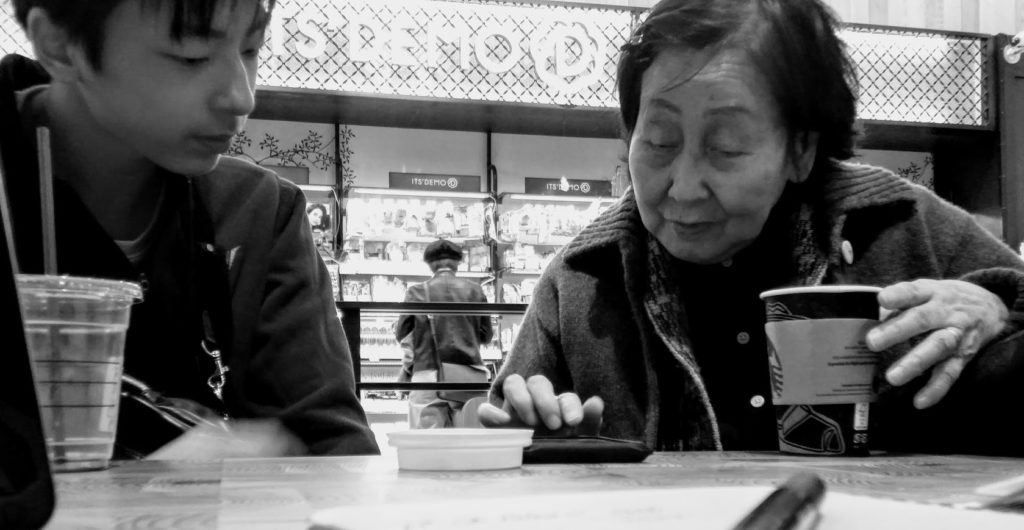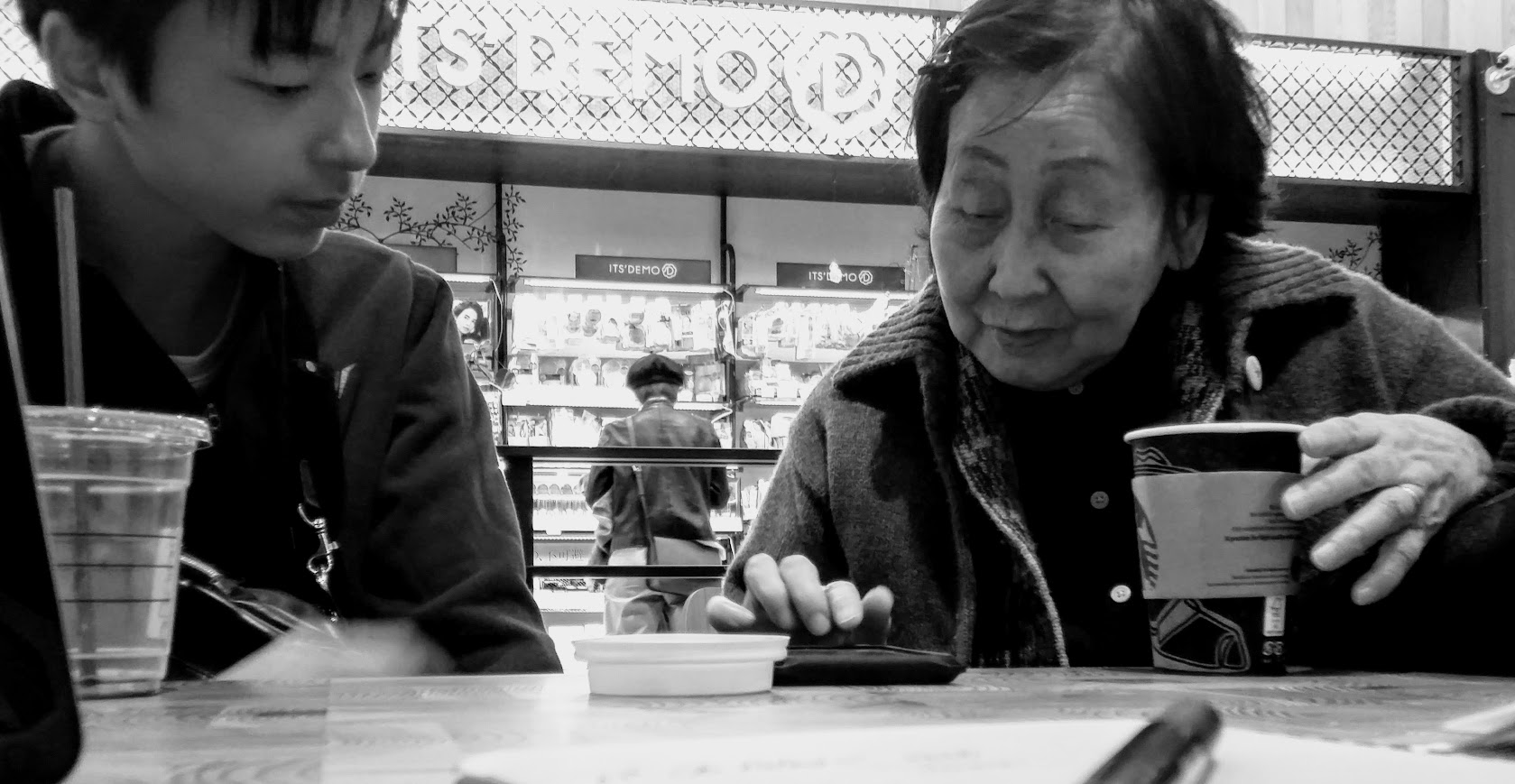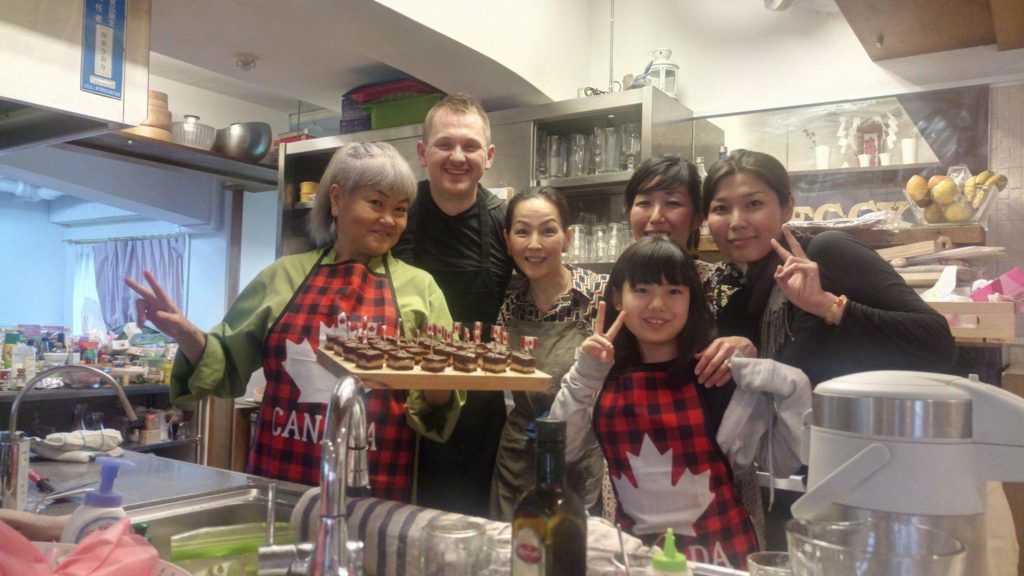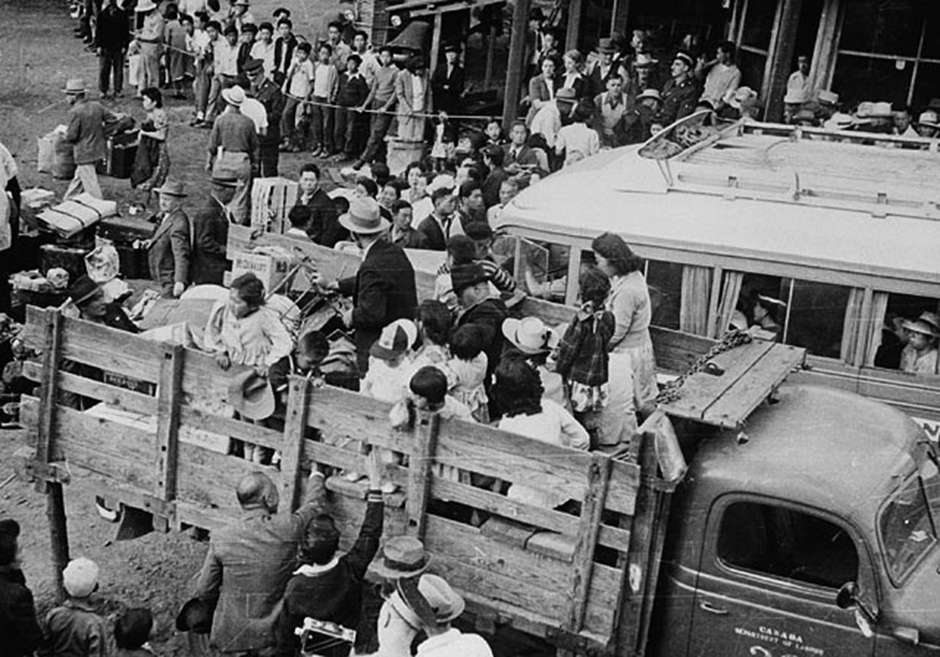
I was at a Starbucks in Tokyo, reviewing the final draft of my book Canadian Vegan Recipes with a friend. We were sitting at a packed communal table.
I was fascinated by the young boy and the elderly woman in front of me. It appeared to be a grandmother in her 80s with a grandson in his teens.
The boy had his grandmother wait at the table while he went to buy drinks for them.
He came back with a hot coffee for her and a cold whipped cream drink for him. She thanked him and drank it slowly. He finished his quickly. She apologized to him, saying that it was hot and she was slow. He assured her that was fine and to take her time, and with such kindness and gentleness.
The boy started playing a game on his cell phone. I thought that’s so much like teens back home, figures, just ignore your grandmother. I turned away but when I looked back, this is when the true fascination for me began and I couldn’t look away.
They had their heads together and were looking at the cell phone together. He was intent on showing his grandmother how the game worked he was playing and encouraged her to play. She was trying to move something with her finger on the touchscreen and would laugh when she would make a mistake and it would go too fast or too far.
He was patient and kept on encouraging her to keep on playing. She kept on playing, smiling and laughing at times, and looked so young when she would laugh. I could easily imagine her younger.
It was such a simple scene but it touched me deeply. I could feel the respect and love between them even though there was probably more than a 60 to a 70-year age gap.
The young treat the elderly in Japan with respect and care. The young and old, and in between, intermingle. Teens hang out together here like they do at home but when different ages are together it’s different. I don’t see the young being bored, disrespectful, or impatient as if they would rather be any other place but there with their parents or grandparents.
After they left, I told my friend that it was so sweet, the grandmother and the grandson together. She said she saw me fixated on them and couldn’t figure out why. I told her I loved seeing them hanging out together and having fun. It didn’t seem like a chore for the teen, he seemed genuinely interested and respectful toward his grandmother.
“Doesn’t that happen back in Canada?” she asked. I replied, “Not really, you don’t see a lot of different generations hanging out together.”
“Why not?” she asked. “I guess the young don’t want to be seen with older people, especially their parents and grandparents.”
“Why’s that?” she was perplexed. “I guess it’s not cool and hip, and appearances are everything.”
“That’s ridiculous, don’t they think they will grow older one day?” she asked. “No, they don’t,” I say. I explain that there is a real focus in our society on being young and staying young. Often older people are stereotyped as frail, lonely, and not useful members of society anymore.
She said when she lived in Canada, the older people seem younger than they are here. They are active, fit, and do so many things. Here it is different she explained, people get older and we help them.
I explained that while it is true that many elderly back home are active and fit, and seem younger, I don’t think they have a choice. If they’re not, there is often no one to look after them so they are put into hospital wards and old age homes. They can’t be vulnerable.
The Japanese society embraces the young, the shiny new technology and trends. However, at the same time, they embrace the old as well, their past and history. This includes the beautiful sakura trees that bloom year after year no matter how old and weathered they are. And this includes the elderly that have gone through much hardship to bring up their children and are now more relaxed as they spend time with their grandchildren
The Japanese remember where they came from, their roots, and have a deep respect and gratitude for this. They also understand the importance of taking care of things and people. These are some of their secrets to living a happy life.
The other is ‘ikigai‘, the Japanese concept of purpose determining one’s value and self-worth.
Yoshiko Matsumoto, a linguistics professor at Stanford University and the author of Faces of Aging: The Lived Experiences of the Elderly in Japan says that a sense of purpose is a foundation for personal growth but shifts as we age. “Responding to that shift with positivity and intentionality is part of normal aging in Japan,” she says.
“One’s ikigai guides why they do what they do each day, from exercise to social engagement to productive contributions and engagement with their families and society.”
She explains that older people in Japan are not hidden and maintaining meaningful social connections is strongly encouraged by society. There’s a profound awareness in Japan “that isolation is not good,” says Matsumoto. “If you have purpose in your life and people around to share your issues, that brings happiness.”
She says that the effects of this attitude and evidence of the role elders play in Japan, is visible throughout the country. “When you walk around Japanese communities,” Matsumoto says, “you don’t just see young people walking to school or work. You see just as many older people on the streets. Aging is embedded in everyday life. You also see older people in the media.”
This explains the elderly I see everywhere moving about on their own, even in their 80s, 90s and beyond, whether shopping or commuting using the long staircases up and down to the subways, while I huff and puff behind them. Slowly and steadily they make their way, one stair at a time, or shuffle along the sidewalk to where they have to go, sometimes bent over a cart to support them.
Ikiga could explain why Japan has the world’s highest life expectancy at 82 years old. Elders there face the same issues as others worldwide, including widowhood and declining health.
I also learned important lessons about aging from my dad George. He was proof that getting older is a fact of nature but being “young” is state of mind.
George danced whenever he heard “a good beat”, and he would ask whoever was around, young or old, to dance with him, or be happy to dance by himself. I would sometimes dance with him, being embarrassed and self-conscious at the people watching us and laughing at him and with him. More than anything, George loved to laugh and make people laugh, especially at his own expense.
At the wake after my father’s funeral, my cousin came up to me and said, “I thought it was wonderful how you used to dance with your dad.” “I know, he was pretty crazy about dancing, wasn’t he?” I chuckled. He said, “My mom always wanted me to dance with her but I wouldn’t.” He paused for a second and when I looked into his eyes there were tears, “I’ve always regretted that now that she’s gone.”
I like to think George is still dancing and laughing even after he died in his late eighties. You can bet if there is a beat, he’ll be there. And if there is a chance to do something funny to make people laugh, he’s there too.
When we can embrace growing old and the elderly as much as we do being young and children, we become grateful for all the distinct and beautiful stages of the life, and ourselves.
Also published on Medium.







0 Comments